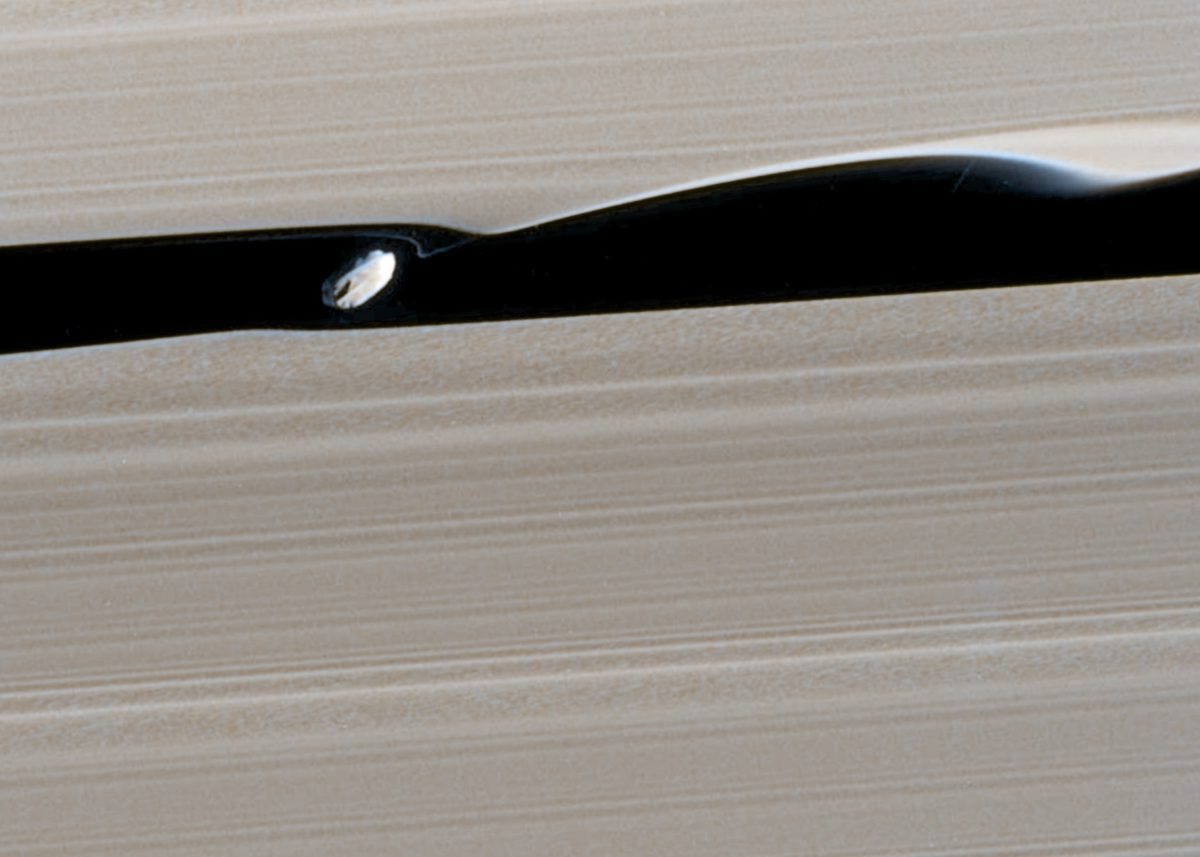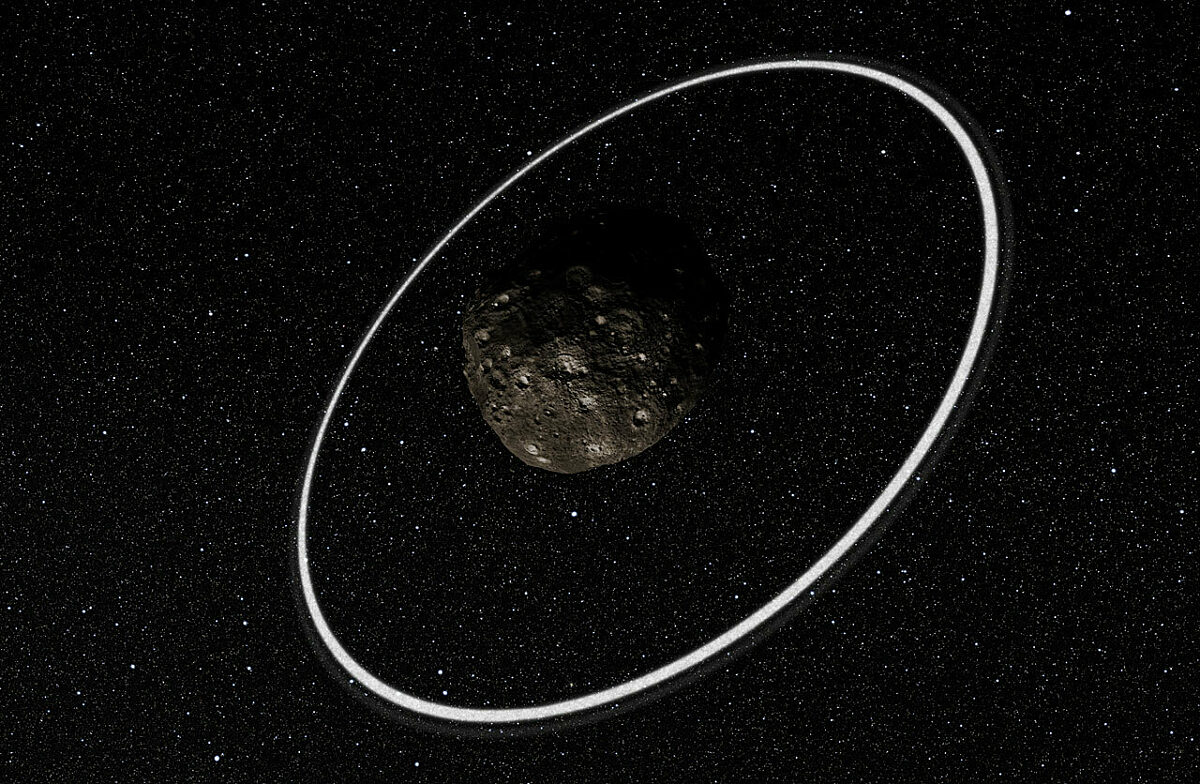Jason Davis • Dec 08, 2022
Your guide to rings of the Solar System
Planetary rings come in all shapes and sizes. It only takes binoculars to spot Saturn’s perfectly sculpted rings, but large telescopes or a space mission are needed to see the dim rings of Jupiter, Uranus, and Neptune. These beautiful, curious structures inspire everything from children’s drawings to sci-fi shows to space missions.
All four of our Solar System’s giant planets have rings. We’ve also found rings around asteroids, a dwarf planet, and a world orbiting another star. This guide will take you on a tour of our Solar System’s marvelous halos and beyond.
Jupiter

Discovery and exploration: Scientists had long suspected Jupiter was circled by rings before NASA’s Voyager 1 spacecraft confirmed it during the probe’s flyby of the gas giant in 1979. Voyager’s wide- and narrow-angle cameras took an 11-minute exposure of Jupiter's ring plane. The wide angle cameras were overexposed by glare from Jupiter itself, but the narrow angle cameras captured the tip of the rings, providing proof of their existence. The Galileo spacecraft explored the rings in more detail during its tour of the Jupiter system from 1995 to 2003.
Structure: Jupiter’s rings are divided into four main sections. Starting at the planet is a donut-shaped halo ring, the main ring, and two faint gossamer rings named Amalthea and Thebe. The Thebe ring also has a faint extension.
Ring moons: Four small ring moons shepherd and interact with each section of Jupiter’s rings. Metis and Adrastea lie at the outer edge of the main ring, Amalthea sits between the Amalthea and Thebe rings, and Thebe orbits at the outer edge of the Thebe ring.

Composition and origin: The rings are mostly dust and small, dark particles kicked up by meteorite impacts on the planet’s small ring moons. Ring material must be continually replenished after it is destroyed by Jupiter’s radiation or gets pushed into the planet, giving the rings an age of less than 1 million years.
Size: From the inside of the halo ring to the outside of the Thebe ring, Jupiter's rings span about 122,000 kilometers (76,000 miles). They fit entirely within the orbits of Jupiter’s larger moons Io, Europa, Ganymede, and Callisto, which prevent a more elaborate ring system from forming. The rings range in thickness from about 100 kilometers (62 miles) in the main ring to 10,000 kilometers (6,200 miles) in the halo ring.
Saturn

Discovery and exploration: Saturn’s majestic rings were bright enough to be seen through Galileo Galilei’s telescope in 1610. However, the legendary scientist wasn’t exactly sure what he was looking at, and thought the rings might be moons or arms of some sort. It wasn’t until 1659 that Christiaan Huygens correctly deduced that Saturn had a ring system that encircled the planet.
Of the five spacecraft that have ever visited Saturn, the most in-depth exploration of the system came from NASA’s Cassini spacecraft. From 2004 to 2017 Cassini studied Saturn’s rings, revolutionizing our knowledge of Saturn and ringed planets in general.
Structure: Resembling a vinyl record pressed with multiple tracks, Saturn’s rings are divided into discrete sections and gaps. The main rings are labeled A through E, but not in that order; they were labeled according to their discovery.
Starting from Saturn and moving outward, the rings are: D, C, B, A, F, G, and finally, E. Beyond the E ring lies some even fainter rings, including the comically large Phoebe ring, which spans an area of space 7,000 times wider than Saturn itself.

Ring moons: Embedded within the ring system are a menagerie of moons that interact with and shape the rings in various ways. Some float through gaps, pushing and pulling ring material, like pierogi-shaped Pan and wave-making Daphnis. Icy Enceladus feeds Saturn’s E ring with water from the moon’s subsurface ocean.
Composition and origin: The rings are mostly made of water ice and rock, likely formed by one or more comets, asteroids, or moons that broke apart under the strain of Saturn’s gravity. Data from the Cassini mission showed that the rings are relatively young, perhaps 10 to 100 million years old, which means they could have formed during the reign of the dinosaurs.

Size: Saturn’s rings span roughly 413,000 kilometers (257,000 miles) from the D ring out to the end of the E ring. When taking the Phoebe ring into account, that number balloons to 12 million kilometers (7.5 million miles). The main rings are exceedingly thin, measuring just 10 meters (30 feet) tall in some spots.
Uranus

Discovery and exploration: Scientists discovered the rings of Uranus in 1977 using NASA’s Kuiper Airborne Observatory. The flying telescope observed Uranus during a stellar occultation, when it passed in front of a distant star. Small dips in starlight before and after Uranus transited the star revealed a ring system.
Our only up-close view of Uranus’ rings came from the Voyager 2 spacecraft, which passed the planet in 1986. Scientists now observe Uranus’ rings with both ground and space-based telescopes.
Structure: Uranus has 13 known rings: Ten narrow rings interspersed with three broad, diffuse rings. The rings are named according to labels used in their discovery papers, creating a mishmash of numbers and Greek letters. Starting from the planet, the inner rings are named 6, 5, 4, α (Alpha), β (Beta), η (Eta), γ (Gamma), δ (Delta), λ (Lambda), and ε (Epsilon). The diffuse rings are named ζ (Zeta), ν (Nu), and μ (Mu).
Ring moons: Uranus’ moons are named after characters from the plays of William Shakespeare and Alexander Pope. The inner moons are tightly packed amongst the rings, with simulations suggesting they sometimes collide with one another like their Shakespearean namesakes.
The only inner moon Voyager 2 managed to image in any detail was Puck, a 150-kilometer-wide (93-mile-wide) world that orbits just inside the Mu ring on the outskirts of the ring system.

Composition and origin: Uranus’ rings are made from some of the darkest materials in the Solar System, and may be rich in carbon. The narrow rings may be made of centimeter-to-meter-sized particles, while the diffuse rings appear to be broad and dusty.
The Uranian ring system may be primordial, having formed alongside Uranus billions of years ago. However, it has likely been reshaped over time due to the chaotic orbits of the rings and moons.
Size: The rings span more than 57,000 kilometers (35,000 miles), measuring from the middle boundaries of the innermost to outermost ring. The inner rings are in some places hardly a kilometer thick, while the diffuse, outer Mu ring is roughly 17,000 kilometers (10,600 miles) thick.
Neptune

Discovery and exploration: Neptune hinted to astronomers that it might have rings during a stellar occultation in 1984. Proof came in 1989, when Voyager 2 captured definitive images of the icy world’s rings. Like Uranus, Neptune’s rings can now be studied with ground and space-based telescopes, although Neptune’s farther distance from the Sun makes studying its rings more of a challenge.
Structure: Neptune has five main rings. Starting from the planet, they are: Galle, Le Verrier, Lassell, Arago, and Adams. The Adams ring is home to transitory clumps of material known as arcs, which have puzzled scientists since their discovery. The rings are named after scientists who made discoveries about the planet; some also participated in a debate over what Neptune should be called.
Ring moons: Like the other giant planets, Neptune has a set of inner ring moons that shepard and interact with the rings. Despina, Naiad, and Thalassa orbit between the Galle and Le Verrier rings. Galatea orbits near the Adams ring and may have some effect on the ring’s arcs. Finally, Larissa, Hippocamp, and Proteus sit on the outskirts of the ring system.

Composition and origin: Like Uranus, Neptune’s ring and moon system may have formed alongside the planet before shuffling around greatly since then. The biggest disruption to the system would have been Neptune’s capture of the Kuiper Belt Object Triton.
The rings are generally dark and dusty, similar to the Uranian rings. Some spots, including the ring arcs, have a reddish hue.
Size: From the middle of the Galle ring to the Adams ring is a distance of just 21,000 kilometers (13,000 miles), giving Neptune the narrowest set of rings out of the giant planets. The Lassel ring is a beefy 4,000 kilometers (2,500 miles) thick, while the Adams ring measures just 15 kilometers (9 miles) thick in some spots.
Small worlds

It turns out planets aren’t the only worlds with rings. In 2013, scientists announced asteroid Chariklo has two rings. Measurements since then have refined the width of the rings to be between five and nine kilometers (three and six miles) wide. Chariklo itself measures 302 kilometers (188 miles) wide. It is the largest known Centaur, a type of asteroid that orbits the Sun between Saturn and Uranus.
Another Centaur named Chiron was announced to have a possible ring system in 2015. Ringed Centaurs may be common, although their distances from Earth makes them a challenge to study.
In 2017, scientists discovered a ring around dwarf planet Haumea, which is located in the Kuiper Belt beyond Neptune’s orbit. A Planetary Society Shoemaker Grant winner helped make the discovery.
There are likely other ring systems in our Solar System that have evaded detection. Mars may have faint dust rings fed by Phobos and Deimos, but efforts to find them have been unsuccessful. Some scientists thought Pluto would have a faint dust ring, but it was not detected when the New Horizons spacecraft flew past the dwarf planet in 2015.
Saturn’s moons Iapetus and Rhea may have once had rings that fell to the surface; Iapetus’ strange equatorial ridge could be remnants of such a system. Mars may get a prominent ring in the future when its moon Phobos breaks apart.
Expolanets

We’d be remiss to end our guide without a quick look at rings in other planetary systems. Many exoplanets likely have rings, just like the ones we see in our own Solar System.
So far, we’ve only found one set of exorings. A giant planet (which could possibly be a brown dwarf star) known as a “Super Saturn” orbiting the star J1407 has 30 rings, each with a diameter of tens of millions of kilometers. If our own Saturn had rings as large as these, they would appear as big as the Moon in our night sky.
So why haven’t we found any other ringed exoplanets? It could be that most exorings are too dim for easy detection. Scientists are continuing to refine detection models, so it’s possible we’ll learn about more exorings in the future.
Let’s Go Beyond The Horizon
Every success in space exploration is the result of the community of space enthusiasts, like you, who believe it is important. You can help usher in the next great era of space exploration with your gift today.
Donate Today

 Explore Worlds
Explore Worlds Find Life
Find Life Defend Earth
Defend Earth

